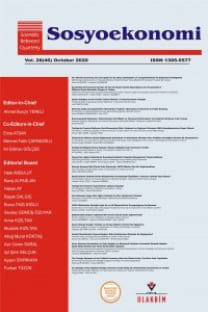The Effects of Oil Price Shocks on Transitional Dynamics of Turkish Business Cycle
In this study we investigated usefulness of oil price shocks in predicting switches between the growth phases of output in Turkey using monthly data for the period 1986-2014 by extending Markov Switching framework to include time-varying transition probabilities. We investigate the issue of whether the addition of various real oil price shocks to a univariate Markov Switching model for output can characterize the dynamics of business cycles better than the fixed transition probability version of Markov Switching model. The main results are summarized as follows. We find that although information about the lags of output growth and the information contained in transition probabilities combine to help identify which state of the economy has occurred in the TVTP model, oil price shocks are not the leading indicator of Turkish business cycle.
Anahtar Kelimeler:
-
The Effects of Oil Price Shocks on Transitional Dynamics of Turkish Business Cycle
In this study we investigated usefulness of oil price shocks in predicting switches between the growth phases of output in Turkey using monthly data for the period 1986-2014 by extending Markov Switching framework to include time-varying transition probabilities. We investigate the issue of whether the addition of various real oil price shocks to a univariate Markov Switching model for output can characterize the dynamics of business cycles better than the fixed transition probability version of Markov Switching model. The main results are summarized as follows. We find that although information about the lags of output growth and the information contained in transition probabilities combine to help identify which state of the economy has occurred in the TVTP model, oil price shocks are not the leading indicator of Turkish business cycle.
Keywords:
-,
___
- Diebold, F.X. & J-H. Lee & G.C. Weinbach (1994), “Regime Switching with Time-Varying Probabilities”, in: C.P. Hargreaves (Ed.), Nonstationary Time Series Analysis and Cointegration, Oxford: Oxford University Press, 283-302.
- Engel, C. & J.D. Hamilton (1990), “Long swings in the dollar: Are they in the data and do markets know it?”, American Economic Review, 80, 689–713.
- Filardo, A.J. (1994), “Business-Cycle Phases and Their Transitional Dynamics”, Journal of Business & Economic Statistics, 12(3), 299-308.
- Hamilton, J.D. (1983), “Oil and the Macroeconomy since World War II”, Journal of Political Economy, 91(2), 228–248.
- Hamilton, J.D. (1989), “A new approach to the economic analysis of non-stationary time series and the business cycle”, Econometrica, 57, 357–384.
- Hamilton, J.D. (1996), “This is What Happened to the Oil Price-Macroeconomy Relationship”, Journal of Monetary Economics, 38(2), 215–220.
- Lee, K. & S. Ni & R.A. Ratti (1995), “Oil Shocks and the Macroeconomy: The Role of Price Variability”, The Energy Journal, 16(4), 39-56.
- Mork, K.A. (1989), “Oil and the Macroeconomy When Prices Go Up and Down: An Extension of Hamilton's Results”, Journal of Political Economy, 97(3), 740–744.
- Raymond, J.E. & R.W. Rich (1997), “Oil and the Macroeconomy: A Markov State-Switching Approach”, Journal of Money, Credit and Banking, 29(2), 193-213.
- ISSN: 1305-5577
- Yayın Aralığı: Yılda 4 Sayı
- Başlangıç: 2005
- Yayıncı: Sosyoekonomi Derneği
Sayıdaki Diğer Makaleler
Kırgızistan Dış Ticaret Dengesinin Belirleyicileri
Jusup PIRIMBAEV, Zamira OSKONBAEVA
Investigation of Economic Activities of Single Parent Families
Muhammet ÖZTÜRK, Ayfer AYDINER BOYLU
İlçeler Düzeyinde Sosyal Sermaye Analizi: Konya ve Karaman Örneği
Enerji Güvenliğinin Doğuşu: Orta Doğu'da İngilizlerin Enerji Politikası (Aynı Atı Üç Defa Satmak)
Vergi Mükelleflerinin Vergi Denetimi Algıları: Çorum Örneği
The Effects of Oil Price Shocks on Transitional Dynamics of Turkish Business Cycle
